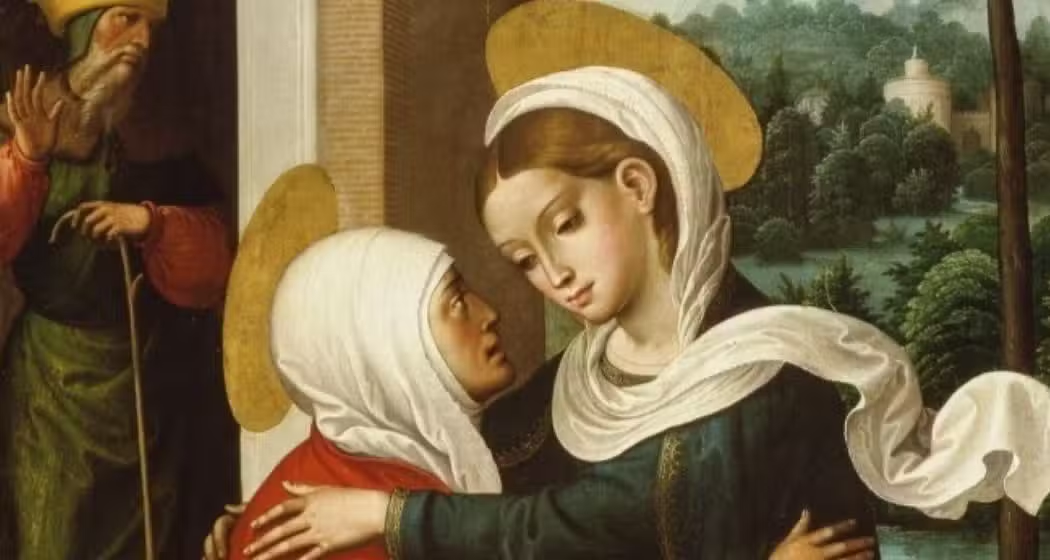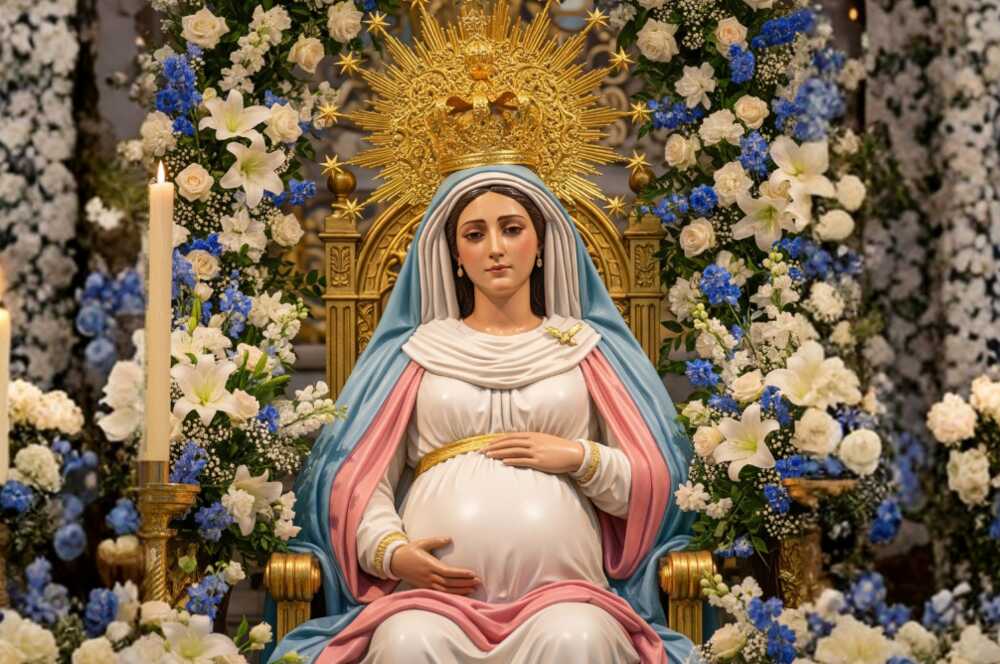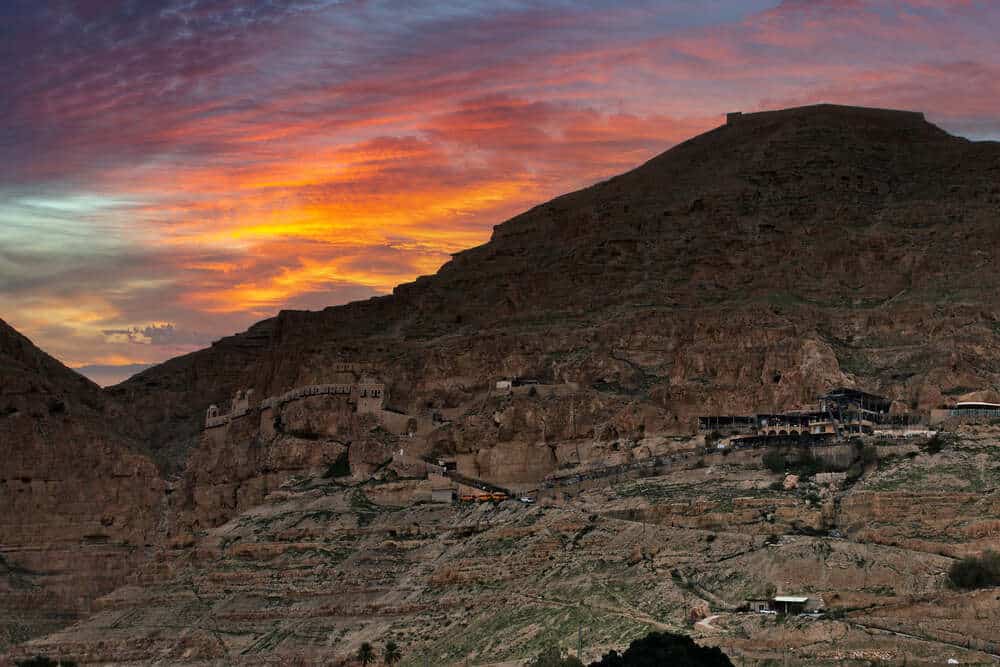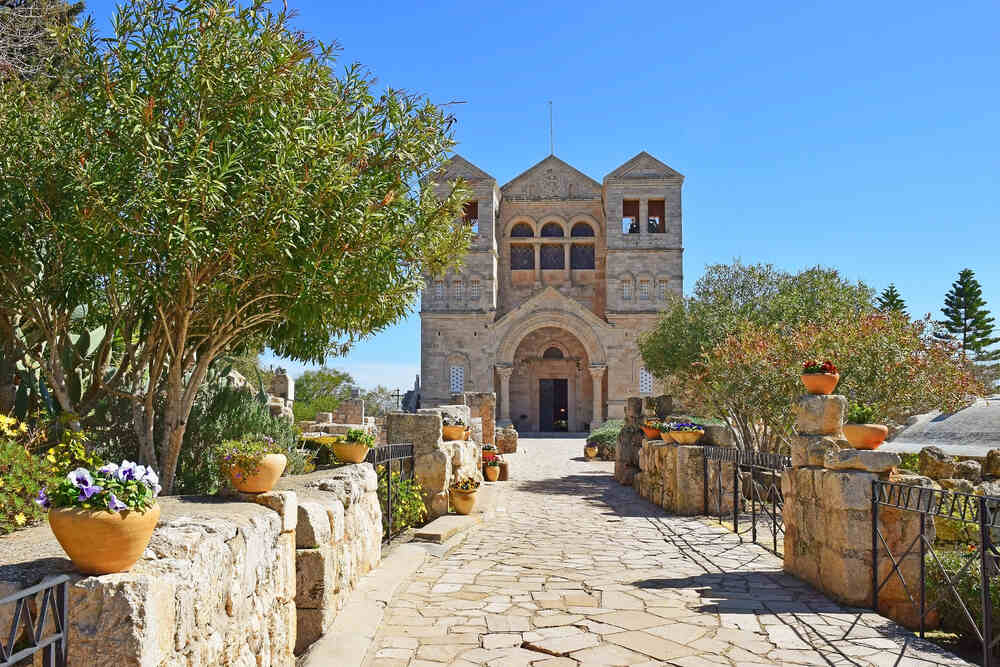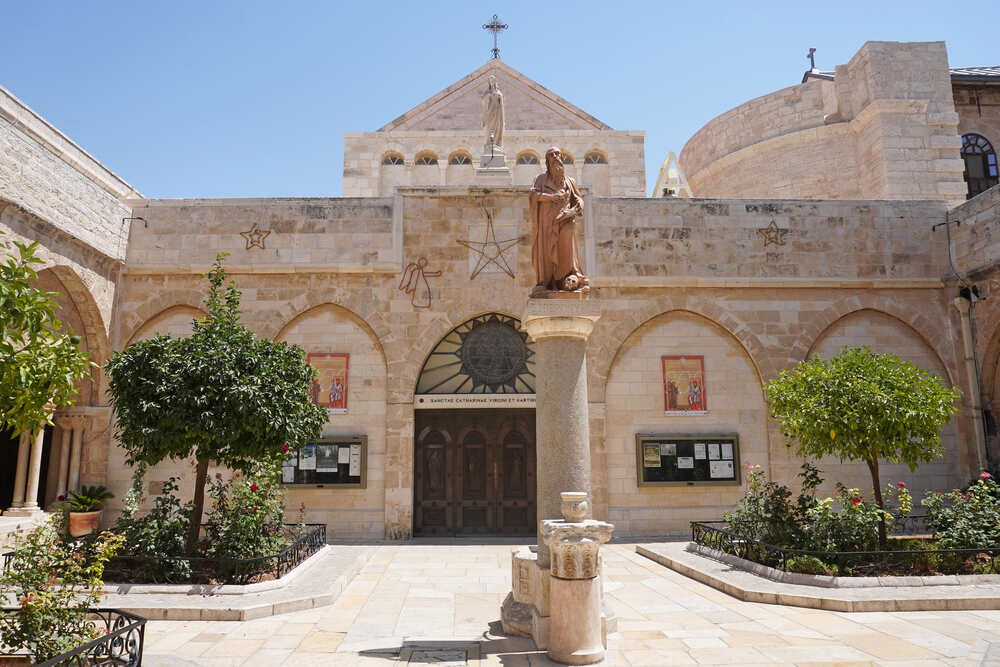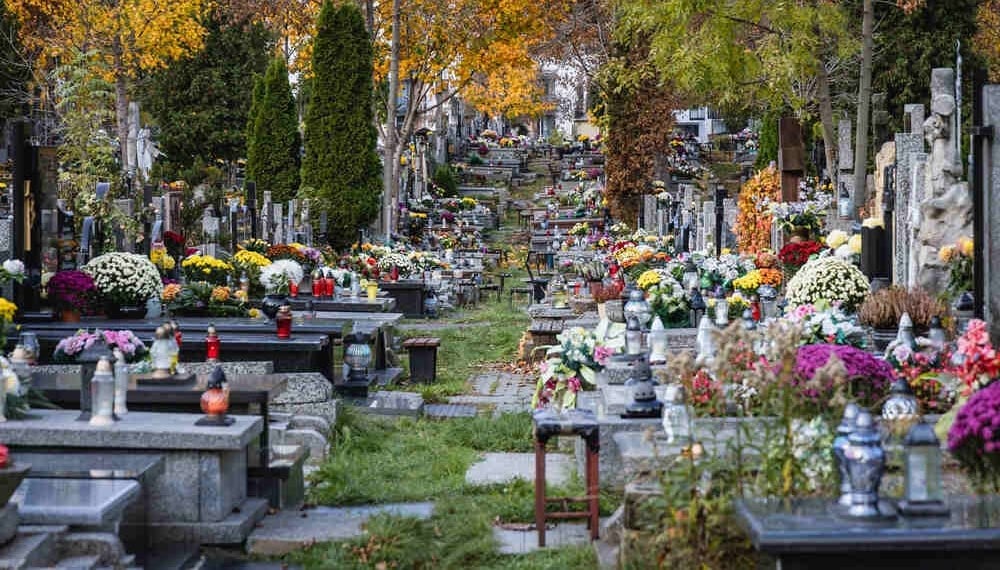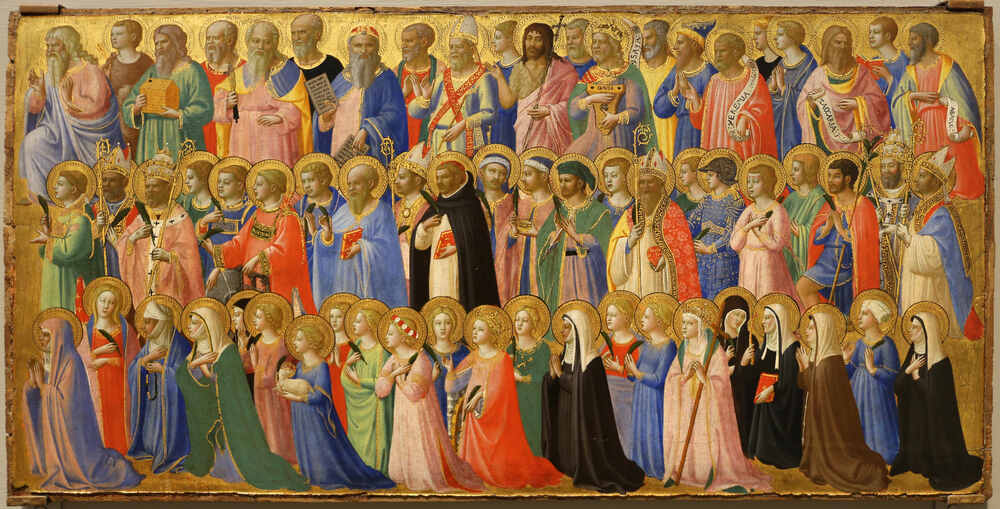Every May 31st, the Church celebrates the feast of the Visitation of the Blessed Virgin to Her Cousin Saint Elizabeth. Moved by charity, Our Lady traveled to serve the elderly Elizabeth, who was six months pregnant. When Mary greeted her, Saint John the Baptist, still in the womb, recognized the presence of the Savior and leapt for joy. Thus, he announced the arrival of the Messiah for the first time.
This celebration originated in the Eastern Church. In Byzantium, on July 2nd, they commemorated the “Deposition of the Holy Robe of the Theotokos” at the Basilica of Saint Mary of Blachernae. There, a veil was venerated which, according to tradition, the Virgin Mary had worn during her visit to Saint Elizabeth. This precious relic had been hidden in earlier times to protect it from looting and was returned to the sanctuary precisely on a July 2nd, a date that marked the beginning of this commemoration. For this reason, the Gospel of the encounter between Mary and Elizabeth was proclaimed during the celebration.
Later, in 1263, the Franciscans adopted this Marian tradition and transformed it into the feast of the Visitation. Its current celebration was established by Pope Urban VI in 1389 with the aim of achieving unity in the Church during the Eastern Schism.
Finally, following the liturgical reform of the Second Vatican Council, the date was moved to May 31st, as the crowning moment of the month dedicated to the Mother of God.
1. The Miraculous Conception of Saint John the Baptist
The Gospel of Luke (1:5–25) recounts that in the days of King Herod of Judea, there lived a priest named Zechariah, from the priestly division of Abijah. His wife, Elizabeth, belonged to the priestly line of Aaron. Both were righteous and devout, as described by the evangelist:
Both were righteous in the eyes of God, observing all the commandments and ordinances of the Lord blamelessly.
However, they carried a deep sorrow: they had not been able to have children, for Elizabeth was barren, and both were advanced in years.
One day, while Zechariah was performing his priestly duties in the Temple, he was chosen by lot, as was the custom, to enter the sanctuary and burn incense. The people were praying silently outside as the smoke of the incense rose toward heaven. Then, in that solemn moment, the Angel of the Lord appeared to him, standing at the right side of the altar of incense.
Zechariah’s heart trembled. Fear completely paralyzed him. But the angel, speaking calmly, reassured him:
Do not be afraid, Zechariah, because your prayer has been heard. Your wife Elizabeth will bear you a son, and you shall name him John. . And you will have joy and gladness, and many will rejoice at his birth, for he will be great in the sight of (the) Lord. He will drink neither wine nor strong drink. He will be filled with the holy Spirit even from his mother’s womb, and he will turn many of the children of Israel to the Lord their God. He will go before him in the spirit and power of Elijah to turn the hearts of fathers toward children and the disobedient to the understanding of the righteous, to prepare a people fit for the Lord
These words astonished the elderly priest. Confused by the announced miracle, Zechariah asked how he could be sure, since both he and his wife were elderly. Then the messenger revealed his identity:
I am Gabriel, who stand before God. I was sent to speak to you and to announce to you this good news.
But now you will be speechless and unable to talk until the day these things take place, because you did not believe my words, which will be fulfilled at their proper time.
The people outside were waiting, puzzled by the delay. When Zechariah finally came out, he couldn’t speak a word. He communicated by signs, and allunderstood that he had seen a vision. After completing his service, he returned home.
Later, Elizabeth, against all odds, became pregnant. For five months she remained hidden in the intimacy of her home. As she embraced the mystery growing within her, she gratefully exclaimed:
So has the Lord done for me at a time when he has seen fit to take away my disgrace before others.
2. The Visitation
When Elizabeth was six months pregnant, the angel Gabriel appeared to the Blessed Virgin Mary and announced that she had been chosen to be the Mother of the Savior. He also revealed:
And behold, Elizabeth, your relative, has also conceived a son in her old age, and this is the sixth month for her who was called barren; for nothing will be impossible for God.”
With complete humility, Mary accepted the divine will and offered herself as the handmaid of the Lord. At that very moment, the Son of God was conceived in her immaculate womb.
A few days later, moved by charity and the joy of her divine mission, Mary set out without delay for a hill country town in Judea—likely accompanied by Saint Joseph.
When she arrived, she entered the house of Zechariah and greeted her cousin. As soon as Elizabeth heard Mary’s voice, the child in her womb—Saint John the Baptist—leapt for joy. Filled with the Holy Spirit, Elizabeth exclaimed:
Most blessed are you among women, and blessed is the fruit of your womb. And how does this happen to me, that the mother of my Lord should come to me? For at the moment the sound of your greeting reached my ears, the infant in my womb leaped for joy. Blessed are you who believed 15 that what was spoken to you by the Lord would be fulfilled.
In response, Mary lifted her heart in praise and proclaimed her song of thanksgiving—the Magnificat:
My soul proclaims the greatness of the Lord; my spirit rejoices in God my savior. For he has looked upon his handmaid’s lowliness; behold, from now on will all ages call me blessed. The Mighty One has done great things for me, and holy is his name.
Mary remained with Elizabeth for about three months, offering her support during the final stage of her pregnancy before returning to her home.
- You may be interested in: Sanctuary of the Visitation.
3. What Lessons Can We Learn from the Visitation?
The Visitation offers us many rich spiritual lessons:
- Docility to the Holy Spirit:
First, Mary sets out “in haste” because those who entrust themselves to God respond promptly to the stirrings of the Holy Spirit. We too must ask for the grace to be attentive to His interior promptings and to act without delay when the Spirit moves us.
- Generosity:
Our Blessed Mother teaches us to go beyond ourselves. She didn’t give in to comfort or use her pregnancy as an excuse (and what a unique pregnancy it was!). She crossed the hill country of Judea to serve Elizabeth. Her soul, surrendered to the Lord, poured itself out in loving service. When we cultivate intimacy with God—who dwells within our souls—we become more attentive and loving toward those around us.
- Bringing Jesus to Others:
In this Gospel scene, we see for the first time Our Lady deeply united to Christ’s redemptive mission. She carries within her the Savior Himself, who is recognized by both Elizabeth and the unborn John the Baptist. At Mary’s arrival, John leaps in his mother’s womb at the presence of Jesus. In that moment, he is freed from original sin, filled with grace, and set apart for his mission as the Forerunner.
In the same way, if we allow ourselves to be shaped by Mary—imitating her virtues and protecting the presence of Christ within us—we can help bring Jesus to many hearts, so that He may be born in them, too.
- Faith and Trust in God:
Mary is the first and greatest teacher of faith. She believed completely that all the Lord had spoken to her through the angel would come to pass. Let us ask her to teach us to live with this kind of faith—to trust blindly in God’s plan for our lives and to surrender to His will.
When we do, we begin to recognize the footsteps of Jesus in our own journey and are convinced that, even in times of uncertainty, nothing is impossible for those who work for Him.
- Humility:
Mary takes no credit for herself in God’s work. Instead, during the Visitation, she sings the Magnificat—a hymn of praise and thanksgiving. She sees herself through the eyes of God: known, loved, and chosen purely by His grace. In this awareness, her heart bursts with joy. Her song of humble praise reminds us of the Lord’s kindness, generosity, and tender love for humanity.
- Gratitude:
Our Lady teaches us that a heart filled with thanksgiving recognizes that everything—both the blessings and the trials—comes from the Lord. Even difficulties, when permitted by God, help us grow in humility, deepen our spiritual life, and trust more fully in His grace, which sustains our efforts.
Could the Blessed Virgin Mary have imagined what her visitation to Saint Elizabeth would accomplish? By simply carrying Jesus, hidden in her womb, she sanctified Saint John the Baptist and began to prepare him for his mission.
John is the last prophet, austere, consecrated from the womb and destined to prepare the way for the Savior. His leap in the maternal womb symbolizes the fulfillment of the promise and the beginning of his prophetic vocation.
Through Holy Communion, we too can carry Jesus within us. With confidence and courage, let us bring Him to those in need. God can work wonders through us—just as He did through Mary—transforming hearts like He did with John at the Visitation.
Let us imitate the Blessed Virgin and place all our trust in the power and infinite wisdom of God!
What is the Visitation?
The Visitation commemorates the moment when the Blessed Virgin Mary visited her cousin Elizabeth after the angel Gabriel announced that Mary would be the Mother of the Messiah and that Elizabeth, though advanced in age, was already six months pregnant.
When is the Visitation?
The Visitation is celebrated on May 31.
What Does the Visitation Teach Us?
The Visitation teaches us to:
- Entrust ourselves confidently into God’s hands.
- Obey quickly and docilely the promptings of the Holy Spirit.
- Go out of ourselves to give ourselves completely to others.
- Always carry Jesus in our hearts and make Him known to every person God puts in our path.
- Not attribute any merit to ourselves, but recognize God’s work in everything.
- Live in continuous thanksgiving for every good received from the Lord.
- Be more humble and trust in His grace to grow in holiness.
What Did Saint Elizabeth Say to Mary During the Visitation?
Saint Elizabeth, moved by the Holy Spirit, exclaimed upon hearing Mary’s greeting:
Most blessed are you among women, and blessed is the fruit of your womb. And how does this happen to me, that the mother of my Lord should come to me? For at the moment the sound of your greeting reached my ears, the infant in my womb leaped for joy. Blessed are you who believed 15 that what was spoken to you by the Lord would be fulfilled.

